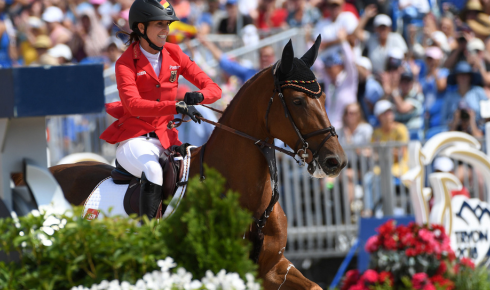
Choosing the Right Horse Jump Standards for Every Riding Discipline
Admin
- 0
Table of Contents:
- Varieties of Horse Jump Standards
- Critical Considerations for Selection
- Material Matters: Understanding Jump Construction
- Safety Features and Injury Prevention
- Adjustability and Competition Readiness
- Maintenance and Longevity
- Cost vs. Value: Balancing Your Budget
Varieties of Horse Jump Standards
Selecting the correct style and type of horse jump standards can elevate both the safety and performance of horses and riders in any equestrian setting. The marketplace offers a broad selection, from classic rustic wooden post standards to modern plastic or metal models. Each possesses unique characteristics that can influence the look and function of your course. For example, show rings often favor elegant wooden standards that blend seamlessly with formal surroundings. At the same time, contemporary training barns turn to lightweight PVC options for their versatility and ease of movement. A vital consideration for any facility is how well its standards accommodate durable horse jumping rails, which must fit securely and support a range of jump heights and types. The right combination not only ensures driven training sessions but also contributes to the aesthetics and safety of your arena.
Advancements in technology have introduced new designs and improved materials, making standards more adaptable, lightweight, and weather-resistant.
Critical Considerations for Selection
Making the right choice in horse jump standards goes far beyond aesthetics. One of the most important factors is whether the standards will be used indoors or outdoors. Indoor arenas typically benefit from lighter, easier-to-relocate standards that won’t damage the flooring. In contrast, outdoor spaces require heavy standards to stay upright during wind or harsh weather. Consideration must also be given to the discipline practiced—hunter, jumper, equitation, or eventing—as each has different height, design, and color requirements.
Ask yourself several key questions before making a purchase:
- Will these standards fit into our daily lesson plans and routines?
- Are they constructed to withstand frequent adjustments and environmental challenges?
- Do I need options that can adapt for both beginners and more advanced riders?
- Are the standards easy to see and free from protruding hardware or sharp edges?
Thoughtfully answering these questions bridges the gap between impulse purchases and investments that stand the test of time. Many trainers work closely with industry professionals or even veterinarians to ensure their choices support soundness and promote confidence in both horse and rider, adapting as skill levels change.
Material Matters: Understanding Jump Construction
The construction material of your horse jump standards impacts everything from maintenance needs to how easy they are to maneuver. Traditional wooden standards are a favorite for shows due to their solid feel, classic aesthetic, and customizable finishes. However, they demand regular upkeep—painting, sanding, and sealing. Fast-paced lesson barns and facilities in areas with unpredictable weather often opt for PVC or synthetic standards, as these resist moisture, are lightweight, and come in bright colors that last for years. Typically constructed of coated aluminum or steel, metal standards are extremely durable and often reserved for permanent fixtures or very windy locations.
Safety Features and Injury Prevention
Safety is central to every decision when equipping an equestrian facility. Recent research highlights that using jump standards with soft, rounded edges helps reduce the likelihood of scrapes and deep cuts during accidental collisions. Additionally, breakaway cups and pins—now widely used—allow rails to fall if hit with significant force, preventing horses from entanglement or more severe injuries. Standards that feature bold, contrasting colors can assist horses and riders in accurately approaching fences, lowering the chances of refusals or run-outs.
- Smooth, sanded edges minimize the risk of abrasions and lacerations
- Breakaway mechanisms on cups/pins allow rails to drop harmlessly, protecting joints and limbs
- Highly visible strips or colored posts help horses judge distance and take-off points more confidently
Regularly reviewing safety guidelines and seeking input from experienced course designers further strengthens the effectiveness of these features. To explore more perspectives on how show jump construction has evolved to put safety first. Proactive investment in safer standards has led to fewer on-course incidents and higher confidence during practice and competition.
Adjustability and Competition Readiness
Adaptability is invaluable, especially for barns that cater to a spectrum of abilities or multiple disciplines. The best jump standards allow for consistent height adjustments with minimal effort. Most quality designs feature multiple cup locations, numbered slots, or color-coded sections so trainers and riders can set accurate, progressive courses. Modular standards take things a step further, empowering barns to create gymnastic lines, combinations, and oxers with creative configurations on the fly.
- Fine-tuned increments let horses adjust to new heights gradually, reducing stress and building positive experiences
- Multiple jump setups simulate a variety of competition scenarios, developing well-rounded, adaptable equine athletes
- Tool-free height changes help keep lessons moving, maximizing valuable riding time
Trainers repeatedly note the advantages of using standards that closely mimic what riders will face in competition. Greater adjustability means fewer surprises at shows and makes horses and riders more agile in adapting to varied courses.
Maintenance and Longevity
Horse jump standards will only last as long as their maintenance schedules dictate. Wooden standards in particular require seasonal attention: regular inspection for splinters, repainting with weather-resistant coatings, and checks for signs of water damage or rot. Plastic and PVC standards, while nearly maintenance-free, should be checked for color fading or sun-induced brittleness. Metal standards benefit from routine cleaning and rust prevention, especially in damp or humid climates.
Establishing a twice-yearly inspection and cleaning schedule improves the appearance of your arena and creates a safer environment. Well-maintained standards are better during heavy use and contribute to a professional, inviting appearance that appeals to boarders, students, and event participants alike. Keeping an up-to-date log or checklist makes it easy for barn staff to track equipment life and necessary repairs.
Cost vs. Value: Balancing Your Budget
Equestrian facilities span many needs and budgets, but making the smart choice with horse jump standards always delivers a better return. While high-end standards might come with a steeper upfront cost, the trade-off regarding stability, safety features, and resilience to frequent use pays dividends. Small lesson barns or private owners may find mid-tier options perfect for their needs, balancing ruggedness and cost-effectiveness.
When weighing cost against value, consider more than just sticker price. Ask about warranties and repair policies, longevity in local climates, and how easily standards adapt to evolving training requirements. Investing in standards that look and function well can also elevate your reputation among clients and peers, setting your facility apart as a space that values both horse welfare and rider achievement.


